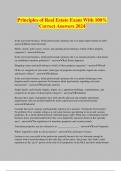Samenvatting
Theories of EMCI (6314M0212Y), Complete Summary (grade 8/10)
- Instelling
- Universiteit Van Amsterdam (UvA)
Complete Summary for Theories of Entrepreneurship and Management in the Creative Industries (6314M0212Y) course, covers all mandatory literature and includes incorporated notes from lectures, easy to read and understand, most important points are put in bold
[Meer zien]








